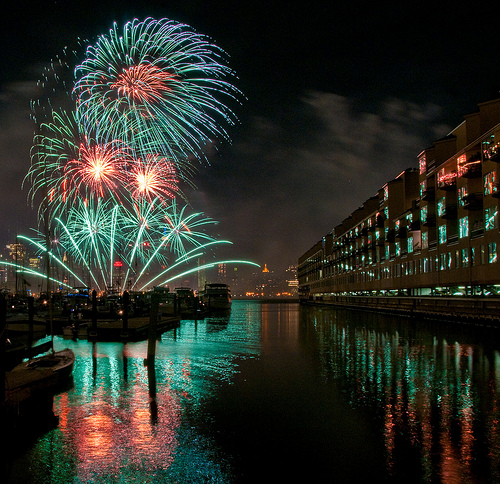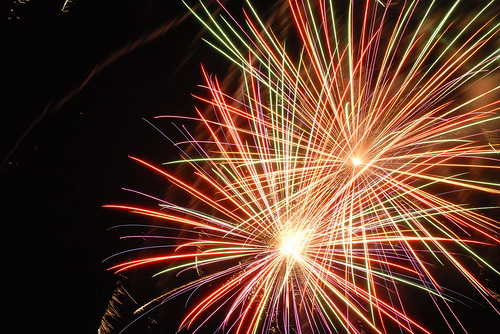Photographing fireworks is not as hard as it seems. This quick guide will get you ready to take the best fourth of July fireworks photos!

There are only two things you really need to know about photographing fireworks to take expert shots:
- Exposure
- Stability
Exposure
The shot at the top was taken with an ISO of 200, an aperture of f/18 and an exposure time of 5 seconds. And that’s a pretty good place to start experimenting with your own exposure settings. If your camera doesn’t have an f/18, try f/11 or f/16 to start.
Notice how the windows in the building reflect the light from the fireworks – that’s neat!
You’ll need to use ‘trial and error’ with this a little – but that’s the joy of using digital cameras. Gone are the days when you had to wait until the next day to have the film developed before you knew whether you’d set the exposure settings correctly!
When you check the preview image look for washed-out colors in the firework trails – a sign that you are over-exposing the scene and need to stop down the lens aperture (ie use a higher numbered f/stop). If everything is too dark, open up your aperture by a stop or two and test again.
The thing to remember when photographing fireworks is that fireworks move. This means that your shutter speed does not change how much time the firework is exposed to the camera sensor – the speed of the firework does.
The exposure of any one firework is not affected by the shutter speed. Adjusting the shutter speed will simply include more or less of the total journey of the firework within your frame and/or allow more fireworks to be recorded.
Against a dark sky, what controls the brightness of the fireworks within your photograph is the lens aperture. Open it up to make the fireworks lighter. Stop it down to make the fireworks darker.
What your shutter speed will control is how brightly other continuously glowing objects in the frame are recorded. So if you have buildings lit by continuous conventional lighting your shutter speed will affect how brightly they come out. Your shutter speed will also affect how brightly any color from the sky is seen in your picture. If you’re shooting at a time of day when there is still some light in the sky, use your shutter to control how that’s exposed (but remember that a short exposure will only capture part of the journey of the fireworks).
If the brightness of the fireworks and the exposure of any conventionally lit areas are too far out of balance then you’ll need to choose between which one you want to be over/under-exposed.

Stability
So first, a tripod. You must use a tripod. If you don’t, due to the need for long exposures to capture the fireworks’ journey, everything will be blurred and you’ll be unhappy with the result.
Plug-in a remote shutter release cable (AKA cable release). This is so you don’t touch the camera and induce any camera shake as you take the photo.
Set the camera shutter control to ‘Bulb’ or ‘B’ (this means that the shutter will stay open for as long as you hold down the shutter release). If you’re camera doesn’t have a Bulb setting then you’ll just have to go for a long, fixed exposure of several seconds.
Now point your lens where you anticipate the fireworks will explode. This is harder to do if you are using a long lens. The nice thing about using a wide angle lens is you can often capture some of the atmosphere; setting the scene for what would otherwise be just another close-up of a firework.
With the camera pointing in the right direction, press the cable release as the firework enters the frame. Wait until it’s done it’s thing and then let go. If you can’t predict the point of explosion accurately, and need to track the firework through the viewfinder, try the trick of keeping both eyes open (see my article here) to help you.
Essential Equipment
- Tripod
- Remote Shutter Release
Hey – loved this post. I feel I’m now ready for July 4!
Good stuff!
Thanks and keep up the good work. 🙂
Pretty nice post. I just stumbled upon your blog and wished to say that I’ve really
enjoyed browsing your blog posts. In any case I will be subscribing to your feed and I hope you write again soon!
I am eхtrеmely imprеsѕеd wіth your writing skills and
also with the layout on yοur weblοg.
Iѕ this а paіd themе οr dіd you modify it yourself?
Anyway keep up the nice quality writing, it’s raгe to see a nice blοg like this one today.